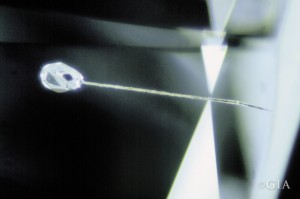Diamond Treatments 101
Not all diamonds are created equal. Only 1% of mined diamonds meet the standards for use in jewelry. But sometimes even gemstone quality diamonds can use a little help to enhance their beauty. In the lab, permanent and non permanent treatments can be used to improve the overall appearance of a diamond. This allows the buyer to get the “look” of a better quality diamond, but for less money.
Clarity Enhancements

Laser drill hole. Image via GIA
Laser Drilling
The appearance of an inclusion can be minimized by using a laser to drill a small tunnel into the diamond. Bleach or acid can then be applied to lighten a dark colored inclusion. While the overall appearance of the diamond of the diamond is improved, this permanent treatment is still noted as a clarity characteristic in lab reports.
Fracture Filling
Molten lead glass is infused into a surface reaching inclusion or laser drill hole to “hide” it from the naked eye. Under a microscope, a rainbow sheen can be detected to identify when this treatment is present. While the treatment may last for years, it is not permanent and must be disclosed to any jeweler prior to repair to avoid damaging the stone. Sometimes, heat from a jewelry repair or cleaning can evaporate the filling. Luckily, the diamond can be sent to a lab to have it refilled.
Color Enhancements

Changing the diamond color. Image via GIA
Irradiation
The diamond is exposed to controlled radiation to change its color. Sometimes the color is changed further by the annealing process but the treatment is usually listed as “Irradiated” only. This non permanent enhancement can be altered due to common jewelry repairs, so make sure to tell your jeweler. And don’t worry, your diamond isn’t radioactive!
High Pressure, High Temperature (HPHT)
The most common color treatment produces a permanent change in color. The diamond is placed in a machine that exerts pressure and heat to simulate its growth environment. This process can transform a dull yellow/brownish colored diamond to the colorless range or to a fancy colored diamond like green, pink, or blue.
Some of these treatments are also used to enhance the color and clarity of colored gemstones. The most important thing to remember is that any stone treatment needs to be disclosed because it can affect the value and care of your jewelry for years to come.







